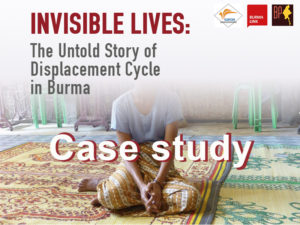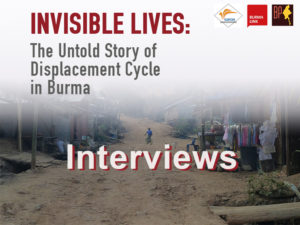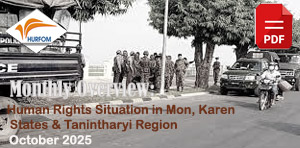Fleeing Sexual Violence from Yebyu Township to the Thailand-Burma Border: Mon IDP Report Case Study #1
September 7, 2016
 The following case study is from the joint report “Invisible Lives: The Untold Story of Displacement Cycle in Burma” by Human Rights Foundation of Monland (HURFOM), Burma Link, and Burma Partnership, which was launched in a press conference in Rangoon on August 12th and in Moulmein on August 15th. The 65-page report focuses on the continuing concerns of the displaced ethnic nationality communities, particularly the ethnic Mon, living along Burma’s southeast border and finds that the recent reforms have not yet addressed the causes of their displacement.
The following case study is from the joint report “Invisible Lives: The Untold Story of Displacement Cycle in Burma” by Human Rights Foundation of Monland (HURFOM), Burma Link, and Burma Partnership, which was launched in a press conference in Rangoon on August 12th and in Moulmein on August 15th. The 65-page report focuses on the continuing concerns of the displaced ethnic nationality communities, particularly the ethnic Mon, living along Burma’s southeast border and finds that the recent reforms have not yet addressed the causes of their displacement.
Download the full report (PDF) in English
Download the full report (PDF) in Burmese
The following is the first case study in a series that HURFOM, Burma Link and Burma Partnership will be publishing in the coming weeks along with a series of selected interviews. The series is meant to give more in depth understanding into the situation of Mon IDPs and villagers. See methodology in the report.
————————————————————————————————————–
Fleeing Sexual Violence from Yebyu Township to the Thailand-Burma Border1: Case Study 1
Mi Sanda Si Aye’s2 mother passed away when she was 18 years old. As the eldest sibling, she took on the role of a mother for her younger siblings. Their father was a fisherman who was often away at sea, and Mi Sanda Si Aye struggled to put food on the table while trying to protect herself and the family from the harassment they often received from the Burma Army.
“I remembered what my aunt had told me; to carry my youngest brother, so they would think I’m a mother with a baby,” Mi Sanda Si Aye says as she recalls one of the times that the Burma Army soldiers came to her house. Her aunt had always reminded her to carry her youngest brother as the soldiers were less likely to take her away to rape her if she was carrying a baby. The houses were far away from each other, and a cry for help would not have been heard between the living quarters. Any time the Burma Army soldiers arrived to her village, men would run and hide to escape forced portering duties that would sometimes last for months. When the men were away, women stayed in the village, becoming easy prey for the soldiers. To protect themselves, the village women slept under the same roof in groups; “If something happened to one of us, the rest of us could scream for help,” Mi Sanda Si Aye explained. The soldiers often returned for information regarding Mon soldiers, leading to threats and interrogation of the villagers. Mi Sanda Si Aye’s cousin once visited a friend in a neighboring village, and upon his arrival, was interrogated, tortured, and finally beaten to death.
When Mi Sanda Si Aye was 19-years-old, she decided to leave the village and take her younger siblings to a safer place. They followed their aunts and walked across the jungle to the Thailand-Burma border. Mi Sanda Si Aye and her family stayed in a refugee camp in Thai-land until they were forced to move back to Burma in 1995. Along with thousands of others, Mi Sanda Si Aye moved to Halockhani IDP site where she has lived for over 20 years. Due to difficulties in making ends meet, her husband is now working in Thailand and sending money to her and their three children. Although she hasn’t faced abuse for decades, Mi Sanda Si Aye says she is still afraid of the Burma Army soldiers because of her experience from the past.
The soldiers tried to take a girl and a mother would pull and grab her daughter tight. By the mother’s scream asking for help, the soldiers didn’t get her daughter. When I saw and heard this kind of story several times, I didn’t dare to live in the village anymore. (Mi Sanda Si Aye)
————————————————————————————————————-
- Mon IDP, FGD and interview with author, Halockhani, 27 February 2016.
- Name has been changed to protect the identity of the individual.
Police conduct an investigation into drugs, sex and firearms trade
September 7, 2016
During August 2016, the local army, local police, special police, border guard forces and the Criminal Investigation Department (CID) Yangon have launched a cooperative mission to eliminate drugs, sex and firearms trade in the town of Three Pagodas Pass (TPP) located by the Thai-Burma Border. Read more
Telenor cell phone tower disturb villagers
September 7, 2016
Telenor Burma, a major mobile operator in Burma, has established its cell phone tower near Kyaung How Monastery in A-lae (middle) Ward in Kwan Sart Village, Thanbyuzayat Township, Mon State. The monks in the monastery, children in a nearby kindergarten and villagers who live near the towers are tired from the disturbance caused by the tower. Read more
Villagers report their village administrator to higher authority for misappropriation
September 7, 2016
The villagers from Khaw Zar Chaung Wa Village, Kyone Nyae Village Track, Southern Ye Township, Mon State have submitted a letter of appeal to the Mawlamyine Township General Administrative Office to request to remove their current village administrator. Read more
Mon women continue their fight at the Mon National Conference 2016
September 7, 2016
The Mon National Conference 2016 was held in Paw Law Kone Village, an area controlled by the New Mon State Party (NMSP), in Kyar Inn Seik Kyi Township, Mon State. The event was held on 3 days from August 22 to 24, 2016.
The conference was organized by the NMSP and 446 representatives from political parties, civil society organizations and the religious community. According to a statement released on August 24, 16% of participants were women. Read more
‘I Am Not Afraid of the Burmese Soldiers, Because I Already Decided that I Will Never Go Back’: Mon IDP Report Interview #1
September 6, 2016
The following interview was conducted as part of the research for the joint report “Invisible Lives: The Untold Story of Displacement Cycle in Burma” by Human Rights Foundation of Monland (HURFOM), Burma Link, and Burma Partnership, which was launched in a press conference in Rangoon on August 12th and in Moulmein on August 15th. The 65-page report focuses on the continuing concerns of the displaced ethnic nationality communities, particularly the ethnic Mon, living along Burma’s southeast border and finds that the recent reforms have not yet addressed the causes of their displacement. Read more
Mudon Land Conflict Remains Unresolved
August 30, 2016
Mudon Township: More than 1000 acres of land in Mudon Township was confiscated in order to make the area a community forest by the Ministry of Industry. This was confiscated during the previous government administration in 2013. Land owners and the Ministry of Industry are disputing with each other and the land confiscation problem still remains unresolved today. Read more
Lamine land owners struggling to retain land
August 17, 2016
In 2004,part of MiKyin Pan’s landin Lamine, Ye Township, Mon State, was confiscated by the former Lamine administrator, U NyuntAung. Today, My Kyin Pan is still trying to retain her land back.
The land is situated in Lamine and Kaw Dwoot village road. The village administrator claimed that the land is located on grazing ground. Read more
Local villagers protest against companies
August 15, 2016
HURFOM: On August 4, 2016 in Ohn Bin Kwin village,Yebyu Township, Dawei District, local villagers came together and protested against companies for not repairing a bridge which has been broken.
The bridge is situated on a stretch of road that companies use daily to get to work. The bridge was broken on July 12, 2016. The companies that the villagers aretargeting are called: TOTAL, PETRONAS, and PTTEP. Read more
Burma Government’s Reforms Must Address Root Causes of Displacement in Ethnic Areas
August 12, 2016
By Burma Link, Burma Partnership and Human Rights Foundation of Monland
[Rangoon, 12 August 2016] – The new government should promote durable solutions for internally displaced persons (IDPs) and refugees along Burma’s southeast border by eliminating obstacles to return and tackling root causes of conflict and displacement, Burma Link, Burma Partnership, and Human Rights Foundation of Monland (HURFORM) said in a joint report released today.
Read more




















































